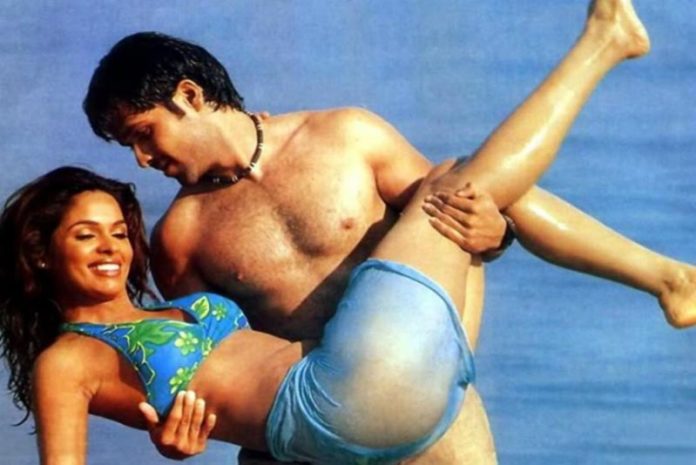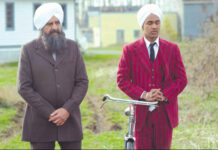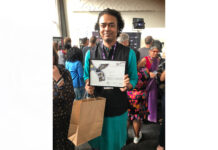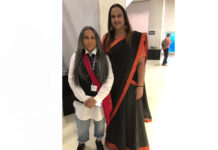By Subhash K Jha
BOLLYWOOD:
Aurat ne janam diya mardo ko, mardo ne use bazar diya
jab jee chaha masla kuchla, jab jee chaha dutkar diya
jin hotho ne inko pyaar kiya, unn hotho kaa vyopaar kiya
jis kokh me inaka jism dhala, uss kokh kaa karobaar kiya
jis tan se ugey kapal bankar, uss tan ko zalil-o-khaar kiya
aurat ne janam diya mardo ko…..
(Lata Mangeshkar Singing Sahir Ludhianvi’s immortal lines on the desecration of Indian womanhood in B R Chopra’s Sadhna in 1958)
“Main kamzor aurat, Yeh meri kahaani
Mere aansoo-on se hai ganga main paani…
Naseebon ne aurat ko samjha khilona
Zamanein ne aurat ko samjha bichona(bed)
Yehi to hua hai yehi to hai hona
Nahin reet badli yeh sadiyon purani
Mere aansoo-on se hai Ganga mein paani.”
(Lata Mangeshkar singing Anand Bakshi’s words on the rape victim’s plight in Rajiv Kapoor’s Prem Granth in 1996)
Aayee chikni chameli ghar se akeli
Pauva lagake aayee
(Shreya Ghosla in Agneepath in 2012 clearly tells the horny men out there that she’s stepped out of alone, drunk and ready for some full-on masti).
There was a time when only the bad girl sang the bad song. Padma Khanna in Johnny Mera Naam (1971) could go that extra mile with Husn ke laakhon rang kaun sa rang dekhoge/Aag hai yeh badan kaun sa aang dekhoge.”
It was the first acknowledged orgasmic number of Hindi cinema where post-pubescent youngsters got a free hand at auto-eroticism.
The objectification of the female form began in the dancing curves of the vamp’s voluptuous frame in the 1970s when the bad girl revealed thighs and uttered sighs.
And that was it.
No male member actually went out there and violated women on the streets although the male gaze has been falling on women on the streets of the Indian cities and villages ever since Adam spotted Eve in a crowded village mela as she cavorted sexily with her sahelis in a skimpy ghagra-choli.
In a nutshell, that is the story of the male gaze in Hindi cinema, gone horribly wrong in recent times.
The gyrations of the average Hindi film heroine now threaten to shake up Parliament. We hear that the Censor Board Of Film Certification plans radical changes in the way women are perceived, specially in the item songs.
Shabana Azmi, who has all along been vocal on the way in which women are portrayed in cinema, feels radical changes are needed in the portrayal of the female form in the so-called item songs.
Says the activist-actress, “Today’s so-called ‘item numbers’ are downright crass. I am not talking about moral policing here. Cinema is about images. Fragmented images of a woman’s heaving bosom, swivelling navel and swinging hips rob her of all autonomy and make her an object of male lust. Voyeuristic camera angles and vulgar lyrics do not celebrate a woman’s sensuality, they demean her. When women are commodified and objectified in films and advertisements, they do not get empowered, they debase themselves and counter the work that the women’s movement has been doing over the decades in creating positive images of women. It’s time our heroines exercised some discretion in choices that they make in their desire for the hit item-number.”
However, Shabana warns against the tarnishing of all specially constructed song-and-dance numbers, a.k.a item songs, with the same paintbrush.
“There are item numbers and item numbers and we must learn to differentiate between them. We can’t make sweeping generalisations that all item numbers are bad. Celebrating a woman’s sexuality in a robust way such as Beedi jalaye le jigar se piya (rooted in our folk tradition) in the film Omkara is liberating and has the woman in control,” says Shabana.
Lyricist-poet Prasoon Joshi feels it’s simplistic to blame Hindi films and songs for women in society being treated as sex objects.
He says, “I wouldn’t blame film songs. Yes, there are some songs and scenes where restrain could have been exercised. It all depends on the intention of the director and the choreographer. If the intent of the filmmaker/writer isn’t titillation but a certain portrayal of the character’s motivation, then it cannot be considered wrong.”
While many prominent actresses chose not to comment on how item songs commodify their persona to titillate the masses, Divya Dutta – who portrays strong assertive women – spoke out saying, “I basically blame repressed societal mindsets for looking at women in a particular way. The lyrics in the popular item numbers are a big turn-on. Ideally, they could be toned down to bring down the suggestive element. But even if item songs are titillating we must not forget they’re sheer entertainment. And they should be treated as such. I certainly don’t think our item songs provoke people to commit ghastly crimes against woman.”
Actress-filmmaker Soni Razdan feels our films definitely play a part in the commodification of women in our society. “Women as objects of desire have been around for decades from Dietrich to Monroe to Meena Kumari to Rekha. Just in different forms and shapes. The celebration of sexuality is a natural impulse. To ban or suppress it would have even more damaging consequences. What is in fact required is a more liberal attitude. Better sex education, less secrecy around the topic of sex. Sex is an essential part of life. The less hypocrisy surrounding this, the more open and mature our society will eventually become.”
Ila Bedi, grand-daughter of the legendary litterateur Rajinder Singh Bedi and daughter of the prolific 1970s director Narender Bedi, feels item songs are a definite provocation.
“Chikni Chameli, Sheila ki jawani and Ooh la la are aimed at providing cheap thrills. Gone are the days when heroines were described as Chaudhvi ka chand and Shabnam ka katra. They call themselves tandoori chicken, fish fry and other edibles, so why should men respect them? With their raunchy pelvic thrusts, item songs definitely commodify women,” says Ila Bedi.
Internationally renowned actress Tannisha Chatterjee feels that crisis of feminine commodification has gone from bad to worse in recent years. “Bollywood doesn’t treat women with dignity. Having said that, I insist no moral policing should happen. But we as artistes should not carry on with the heaving and thrusting as things that audiences want.”
Filmmaker Reema Kagti, who lately portrayed Rani Mukherjee and Kareena Kapoor as strong assertive women in Talaash , admits our films commodify women.
“Songs definitely do their fair share of that. But to me the overall misrepresentation of women in our films is a bigger problem.Writers and directors need to get more sensitive . They need to understand women better before portraying them.”
Filmmaker Tanuja Chandra, who made an important film Sangharsh on rape, feels cinema must take the blame for the way the country looks at women, saying, “Art cannot really change society. But it plays a role in forming opinions, attitudes and perceptions.Even if films are just a reflection of society they must question the prevalent perceptions in society.Entertainment can’t function in a vacuum.”
Kabir Bedi, who has often been an object of the female gaze, brings up the interesting point of men being commodified. “Handsome hunks are taking off their shirts all the time. Bollywood has its own style of entertainment. It needs to do some re-thinking on the question of eve-teasing. Or else in this climate of censure the censor board may soon demand disclaimers saying, ‘Everything You See Is Entertainment. Do Not Imitate In Real Life’,” says Kabir Bedi.
He feels women’s sex appeal has always been a staple diet for films, fashion,television and advertising. “Why point fingers now?”
Kabir’s outspoken daughter Pooja Bedi agrees. “Men are commodified as much as women. There is absolutely nothing wrong with either sex being sexy and desirable!. When a woman is in charge of her sexuality, it is a sign of a woman’s strength, not her weakness. However, the message to all men is, look but don’t touch.”
Pooja feels the commodification of women goes back beyond cinema. “It starts with the education and upbringing of a male child in his home where he’s taught how to treat women. He watches how his mother and sister are treated. Don’t blame films. They are mere entertainment. And the men are flaunting their bodies more than women in our films,” says Pooja Bedi.
Filmmaker and industry spokesperson Ashok Pamdit objects to the word commodification. “Let’s stop using that word. If a heroine exposes her body, so does the hero in this era of 6 packs. Film stars are in the business of physical beauty and entertainment. We showcase it.We don’t sell it. If a working woman wears makeup to office it doesn’t mean she is commodifying herself for the men at her workplace. The same goes for actresses. They have to look good. Whether an actor or an actress it is the era of commodification, if that’s what you want to call it.”
Tamil actress Khushboo, who has in the past been in the eye of moralistic storms, says cinema shouldn’t be blamed for the objectification of woman. “We need some medium to pass on our failures and shortcomings. Why blame cinema? It is a medium of entertainment. Even smoking causes cancer. How many have stopped smoking because of the health hazard?”
In the final count, it would seem as though some radical changes would have to be implemented in our cinema’s approach to and perception of woman.
About time! As Naseeruddin Shah states in his blunt manner, “I’m afraid our population has become desensitized to rape because of cinema. In our movies it is an act that is either foiled or avenged by the hero. So I don’t think people have a realistic view of this ghastly crime. For the first time, the gruesome details of what transpired during the actual act of rape came out in the public domain. I think that caused the public outrage. And that’s good. I just hope this outrage is sustained and doesn’t become one more token protest.”








